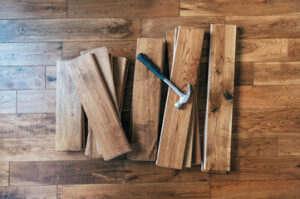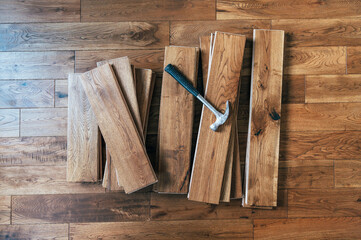Types of Flooring
Flooring is a big part of your home’s overall design and aesthetic. It can help you create the perfect look & feel for your space, improve acoustics, and provide comfort. When deciding on the right flooring, it’s important to think about your needs and budgetary limitations. Plenty of options include hardwood, tile, vinyl, and carpet.
 Hardwood flooring is one of the most popular floor coverings for residential and commercial applications. It is a natural product that offers a variety of benefits, including longevity, durability, and low maintenance. It is also available in various colors, textures, and tones. This variety makes it an excellent choice for various decor styles.
Hardwood flooring is one of the most popular floor coverings for residential and commercial applications. It is a natural product that offers a variety of benefits, including longevity, durability, and low maintenance. It is also available in various colors, textures, and tones. This variety makes it an excellent choice for various decor styles.
Characteristics: Wood is a natural material that will change over time, acquiring subtle shadings of color and picking up small scratches and nicks as it wears and ages. This gives it a unique personality that can’t be purchased. A good example is oak, which may have a slight reddish tone as it ages and acquires small scratches. These scratches will eventually show through in a way that is pleasing to the eye and can make a floor seem more interesting than before it was installed.
Another advantage of hardwood is its long lifespan, with many different species available. Some are more durable than others, so you can select the type that best suits your home’s needs. If you want to install a hardwood floor, hiring a professional for the job is recommended. This will help ensure the flooring is installed correctly, leading to long-term success.
Some types of hardwood floors are more difficult to install than others, and it is important to consult a professional for advice on how to properly get the job done. This is especially true for the more complex jobs that involve cutting, nailing, stapling, and/or gluing. Engineered hardwood is a slightly more water-resistant alternative to solid hardwood and is often more affordable. However, it is susceptible to moisture penetration and can be prone to discoloration and warping.
Laminate flooring is a synthetic fiberboard product that mimics the look of hardwood. It is usually made from four layers: a stabilizing layer, a treated high-density fiberboard, a photographic pattern layer, and a clear melamine resin layer. While it may not look like a traditional hardwood floor, laminate is a more cost-effective option for various purposes. It is more resistant to moisture and can be refinished several times. It is also easier to clean than wood and can be used in areas where spills are a concern, such as kitchens and bathrooms.
Tile flooring is a popular and versatile choice for both residential and commercial applications. It is durable and requires minimal maintenance, making it a great option for high-traffic areas.
There are many different kinds of tile, each with its own style and color options. The most common types of tiles include ceramic, glass, and natural stone.
Natural stone tiles can be made from a variety of materials, such as granite, marble, and slate. They can also be cut into various shapes and sizes and are available in preformed and modular forms.
In many cases, a variety of grout lines are used between the tiles. This can help reduce the likelihood of scuffing, scratching, and chipping while also adding a sense of depth to the floor.
Another option is to use a variety of smaller tiles, each with its own thickness, pattern, and color. This makes it easier to match the tile’s texture and appearance to other flooring in the room, including carpeting.
Some varieties of ceramic tile can be shaped to create patterns or a decorative design. These are typically glazed, but there are also non-glazed styles.
Other options include using small tiles with grout lines that act as grooves or imprinting a contour pattern onto the face of the tile. This helps to make it more resistant to slipping and falls, especially when the floor is wet.
Ceramic tiles are usually very hard and can withstand heavy traffic and water. They are also more resistant to scratches and dents than some natural stone tiles.
These types of tiles are often found in high-traffic rooms like kitchens and bathrooms, as they are easy to clean and maintain. They are also a good option for basements and laundry rooms, as they are resistant to moisture.
There are also a number of specialty tiles, such as terracotta tiles, which are made from a clay product that is fired at high temperatures to create a thicker and heavier tile. They are more resistant to scuffing and scratching than other types of tiles and can be designed with a decorative edge, such as beveled edges or a bullnose edge.
Vinyl floors are a popular option for many homeowners as they offer a range of options and can be customizable. They are also waterproof and easy to clean.
They can be a great budget-friendly flooring option as they cost significantly less than hardwood and have a higher resale value impact on properties. However, there are some key considerations to consider before deciding on this material.
Firstly, it’s important to understand what the different types of vinyl floors are and why they are so popular. This will help you choose the best option for your home.
Luxury vinyl tiles are available in both tile and plank formats and come in a variety of colors, patterns, and styles. They are a more affordable alternative to real wood floors and can look great in the right interior design.
They are also available in several installation options, including glue-down, loose-lay, and click systems for floating floor installation, which makes them easier to install and DIY-friendly.
Another great feature of these types of floors is that they are extremely durable, which means that they can handle heavy traffic and remain in good condition. They are especially ideal for high-traffic areas such as kitchens and bathrooms and will not show any signs of wear over time.
As with any flooring, it is important to keep your floors clean by regularly sweeping them. This will help to prevent dirt from building up and making them difficult to maintain.
It is also a good idea to keep your vacuum cleaner away from the floors as it can scratch them. This can be prevented by using a vacuum that doesn’t contain a beater bar and is safe to use on your floors.
A great advantage of vinyl is that it has antibacterial properties, which makes it a good choice for families with bronchial asthma and allergies. It also has high resistance to moisture, which makes it an excellent choice for bathrooms and kitchens where a lot of water can be present.
It is important to remember that these floors are made of synthetic materials, and as such, they may not be able to match the durability of natural timber. It is also possible for these floors to become stained if they are exposed to heavy amounts of water or chemicals.
Carpets are an elegant and durable flooring option suitable for a wide variety of applications. They are also easy to install, clean, and maintain. In addition to being good-looking and environmentally friendly, they are also a great way to reduce noise and increase energy efficiency in your home or business.
Carpets come in a variety of forms and sizes, from the traditional wooly to the synthetic polyester or polypropylene variants. They are also made in a wide array of colors and designs to suit your every need. The best part is that they are available at affordable prices, making them a popular choice amongst homeowners and commercial businesses alike. The name of the game is finding a carpet supplier that can help you make the right selection for your needs. Whether you’re looking to replace existing flooring or want to spruce up your office space, we can assist with everything from budget-friendly options to high-end designer brands. Our experts are on hand to provide the unbiased advice and guidance you need to find a solution that works for your home or business.


